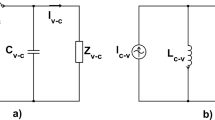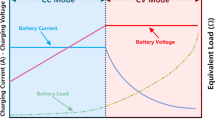Abstract
In an inductive battery charging system, for better power transfer capability and attaining required power level, compensation is necessary. This paper analyzes series/parallel (S/P) and dual side inductorcapacitor- capacitor (LCC) compensation topologies for inductive power transfer of electric vehicle (EV) battery charging system. The design and modeling steps of inductive power transfer for electric vehicle battery charging system are presented. Besides, the equivalent electrical circuits are used to describe the circuit compensation topologies. The results convey that the efficiency of dual side LCC compensation is higher than that of S/P compensation at variable mutual inductance (misalignment).
Similar content being viewed by others
References
Covic G A, Boys J T. Modern trends in inductive power transfer for transportation applications. IEEE Journal of Emerging &Selected Topics in Power Electronics, 2013, 1(1): 28–41
Li S, Li W, Deng J, Nguyen T D, Mi C C. A double-sided LCC compensation network and its tuning method for wireless power transfer. IEEE Transactions on Vehicular Technology, 2015, 64(6): 2261–2273
Qu X H, Jing Y Y, Han H D, Wong S C, Tse C K. Higher order compensation for inductive-power-transfer converters with constant-voltage or constant-current output combating transformer parameter constraints. IEEE Transactions on Power Electronics, 2017, 32(1): 394–4053
Li WH, Mi C C, Li S Q, Deng J J, Kan T Z, Zhao H. Integrated LCC compensation topology for wireless charger in electric and plug-in electric vehicles. IEEE Transactions on Industrial Electronics, 2015, 62(7): 4215–4225
González-Santini N S, Zeng H, Yu Y, Peng F Z. Z-source resonant converter with power factor correction for wireless power transfer applications. In: 2016 IEEE Energy Conversion Congress & Exposition, Milwaukee, WI, USA, 2017
Wei Z, Siu-Chung W, Tse C K, Qianhong C. Design for efficiency optimization and voltage controllability of series-series compensated inductive power transfer systems. IEEE Transactions on Power Electronics, 2013, 29(1): 191–200
Joy E, Dalal A, Kumar P. Accurate computation of mutual inductance of two air core square coils with lateral and angular misalignments in a flat planar surface. IEEE Transactions on Magnetics, 2013, 50(1): 1–9
Covic G A, Boys J T. Inductive power transfer. Proceedings of the IEEE, 2013, 101(6): 1276–1289
Li S, Mi C. Wireless power transfer for electric vehicle applications. IEEE Journal of Emerging & Selected Topics in Power Electronics, 2015, 3(1): 4–17
Hou J, Chen Q, Wong S C, Tse C, Ruan X. Analysis and control of series/series-parallel compensated resonant converters for contactless power transfer. IEEE Journal of Emerging and Selected Topics in Power Electronics, 2015, 3(1):124–136
Joy E R, Kushwaha B K, Rituraj G, Kumar P. Analysis and comparison of four compensation topologies of contactless power transfer system. In: International Conference on Electric Power & Energy Conversion Systems, Sharjah, United Arab Emirates, 2016
Choi W P, Ho W C, Liu X, Hui S. Comparative study on power conversion methods for wireless battery charging platform. In: 2010 14th International Power Electronics & Motion Control Conference, Ohrid, Macedonia, 2010
Wang C S, Covic G, Stielau O. Power transfer capability and bifurcation phenomena of loosely coupled inductive power transfer systems. IEEE Transactions on Industrial Electronics, 2004, 51(1): 148–157
Zhang Y, Chen K, He F, Zhao Z, Lu T, Yuan L. Closed-form oriented modeling and analysis of wireless power transfer system with constant-voltage source and load. IEEE Transactions on Power Electronics, 2016, 31(5): 3472–3481
Nagatsuka Y, Ehara N, Kaneko Y, Abe S, Yasuda T. Compact contactless power transfer system for electric vehicles. In: 2010 International Power Electronics Conference, Sapporo, Japan, 2010: 807–813
Chuan B T, Kato M, Imura T, Sehoon O, Hori Y. Automated impedance matching system for robust wireless power transfer via magnetic resonance coupling. IEEE Transactions on Industrial Electronics, 2013, 60(9): 3689–3698
Sample A P, Meyer D A, Smith J R. Analysis, experimental results, and range adaptation of magnetically coupled resonators for wireless power transfer. IEEE Transactions on Industrial Electronics, 2011, 58(2): 544–554
Cheon S, Kim Y H, Kang S Y, Lee M L, Lee J M. Circuit-modelbased analysis of a wireless energy transfer system via coupled magnetic resonances. IEEE Transactions on Industrial Electronics, 2011, 58(7): 2906–2914
Joy E R, Kumar B, Rituraj G, Kumar P. Impact of circuit parameters in contctless power transfer system. In: IEEE International Conference on Power Electronics, Drives and Energy Systems (PEDES), Mumbai, India, 2014
Bosshard R, Kolar J W. Multi-objective optimization of 50 kW/85 kHz IPT system for public transport. IEEE Journal of Emerging & Selected Topics in Power Electronics, 2016, 4(4): 1370–1382
Sanghoon C, Yong-Hae K, Kang S Y, Myung-Lae L, Jong-Moo L, Zyung T. Circuit-model-based analysis of a wireless energy-transfer system via coupled magnetic resonances. IEEE Transactions on Industrial Electronics, 2011, 58(7): 2906–2914
Green A W, Boys J T. 10 kHz inductively coupled power transferconcept and control. In: 5th International Conference on Power Electronics & Variable-speed Drives, London, UK, 2002: 694–699
Elliott G A J, Covic G A, Kacprzak D, Boys J T. A new concept: asymmetrical pick-ups for inductively coupled power transfer monorail systems. IEEE Transactions on Magnetics, 2006, 42(10): 3389–3391
Villa J L, Sallán J, Llombart A, Sanz J F. Design of a high frequency inductively coupled power transfer system for electric vehicle battery charge. Applied Energy, 2009, 86(3): 355–363
Moradewicz A J, Kazmierkowski M P. Contactless energy transfer system with FPGA-controlled resonant converter. IEEE Transactions on Industrial Electronics, 2010, 57(9): 3181–3190
Li S Q, Mi C C. Wireless power transfer for electric vehicle applications. Journal of Emerging and Selected Topics in Power Electronics, 2015, 3(1): 4–17
Kishan D, Nayak P S. Wireless power transfer technologies for electric vehicle battery charging — a state of the art. In: 2016 International Conference on Signal Processing, Power and Embedded System, Paralakhemundi, India, 2017: 2069–2073
Liu C, Ge S K, Guo Y, Li H, Cai G W. Double-LCL resonant compensation network for electric vehicles wireless power transfer: experimental study and analysis. IET Power Electronics, 2016, 9 (11): 2262–2270
Author information
Authors and Affiliations
Corresponding author
Rights and permissions
About this article
Cite this article
Nayak, P.S.R., Kishan, D. Performance analysis of series/parallel and dual side LCC compensation topologies of inductive power transfer for EV battery charging system. Front. Energy 14, 166–179 (2020). https://doi.org/10.1007/s11708-018-0549-z
Received:
Accepted:
Published:
Issue Date:
DOI: https://doi.org/10.1007/s11708-018-0549-z




